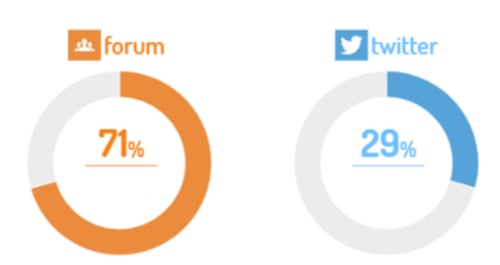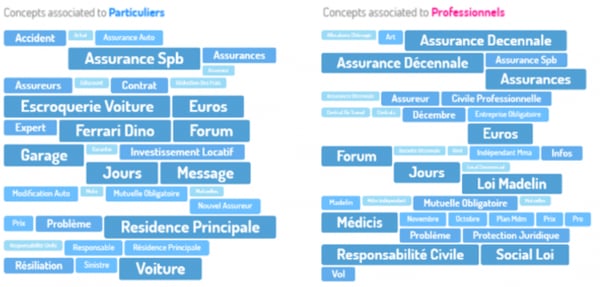How to Retain Customers and Increase Sales Using Social Insights
Three case studies which demonstrate how social listening can improve your communication strategy and customer service.
B2B marketing can be summarized by two challenges: driving of sales and efficient budget spending. Meeting these goals requires marketers to successfully improve the ROI on the efforts of their programs. Consumer profiling and social data analysis provide key customer insights which help marketers better allocate their budgets and increase ROI.
The Importance of Customer Profiling
Customer loyalty is critical to the success of a business; the following statistics illustrate the strong relationship between customer retention and profitability:
- A 2% increase in customer retention has the same effect on profits as reducing costs by 10%.
- Acquiring new customers costs up to 5 times more than satisfying and retaining current customers.
- Loyal customers are 15 times more likely to increase spending than high-risk and intermittent customers.
However, customer retention is only half the battle. Marketing specialists use customer profiling not only to understand their top customers, but to acquire more customers similar to them. Consumer profiling yields information which when supplemented with purchase and response behavior data allows marketers to more precisely segment their target market.
Sophisticated consumer profile analysis can even reveal highly specific psychographic traits such interests and hobbies of consumers within the target market. This information improves both effectiveness of the marketing strategy and consumer experience, as the content and the message are adapted directly to their interests.
To summarize: active listening in social networks provides actionable intelligence on the target market. This post will demonstrate practical and cost-effective ways to gather and use customer profiling data.
Using Social Data to Create Better Products
Social monitoring tools have the capacity to perform sentiment analysis to detect, identify, and categorize the feelings and opinions consumers express towards a brand’s products and services. Such analysis allows brands to gain candid customer feedback to understand and improve on the flaws of their products and to inform subsequent production.
An alternative method is to generate smaller datasets by running focus groups based on social networks. Asking the target audience what they like and dislike about a product provides qualitative data.
Case study
A Digimind Social customer wanted to monitor online mentions of their products to measure and improve their reputation.
Methodology
The project consisted of:
- A geographic analysis of 4 different markets
- Monitoring of 3 different languages
- Analysis of the main competitors in each market
The Study
The brand analyzed the mentions of its products, origin of the mentions by social media channel and user profile, and to what extent the brand was mentioned in specialized media. They then benchmarked what they found against competing products to identify the most popular features in the market and adapt their offerings in light of those.
In addition, the brand analyzed the timbre and volume of their mentions to get a comprehensive view of the user sentiments. They monitored social media around new product launches to see how they were received, paying special attention to mentions relating to product quality, and any issues customers were having with them: update problems, reliability, ease of use, and so on.
With this analysis the brand was able to obtain information about their consumers and the market’s perception of their product. Fortunately, they discovered that their services were regarded as reliable, as evidenced by the positive feedback from their communities.
 A sentiment analysis of the brand's customer services, via Digimind Social.
A sentiment analysis of the brand's customer services, via Digimind Social.Using Data to Improve Your Communication
Marketing specialists understand that a solid content strategy contributes to increased engagement. Analyzing social media data helps accomplish this by allowing them to:
- Understand their audience
- Understand the channels where the most relevant conversations take place
- Discover the topics behind these conversations
- Detect the content that is most commonly shared
- Follow reactions to current events
- Find breaking news to create content in real time
Case Study
A Digimind Social customer in the insurance sector wanted to use social intelligence to adjust the products it offered and adapt its public communications. To do this, the company monitored to how its clients spoke about life and non-life insurance on social media platforms.
Methodology
The customer created classification lists to identify customers who talk about non-life insurance, non-life products, and insurers. It then qualified them according to previously presented elements to discover:
- The type of customer (Individual or company?)
- The type of product (Home, Auto, Education, Health, etc.)
- The presence of insurers (Did the user quote an insurance player? If so, which one?)
The client subsequently analyzed the channels that concentrated the greatest number of conversations among non-life insurance users. These channels helped identify keywords, popular hashtags, and themes of the conversations. With this information, the brand developed a profile of these users.
 A graphic illustrating the volume of relevant conversations across social media platforms, via Digimind Social.
A graphic illustrating the volume of relevant conversations across social media platforms, via Digimind Social.The Study
The company’s analysis revealed that online forums and Twitter were the best platform to identify the language customers used to discuss insurance. Sentiment analysis revealed that most of the mentions were neutral and expressed a desire for more information about insurance, while negative mentions referred largely to bad experiences with customer service.
By qualifying the online mentions, the brand was able to identify topics which generated the most conversation. This analysis was divided into three main indicators:
- Keywords used
- Main topics covered
- Linked subtopics
 A graphic analysis of the concentration and frequency of keywords, via Digimind Social.
A graphic analysis of the concentration and frequency of keywords, via Digimind Social.
With this analysis, the brand built customer profiles based on channels, mentions, and methods of searching for information. In forums, where users were often anonymous, the brand could segment customers based on the situations they discussed in their comments. For example, a household product was targeted at users who identified themselves through their online discussions as living in a cohabitation and people waiting to get a mortgage.
Result
With this analysis, the company was able to associate social profiles with certain products and specific uses of these products. This helped not only to meet the demands of existing customers, but to additionally better communicate new offers to prospective clients.
Using Data to Improve Customer Service
As social media evolves, so does customer service strategy. Today, it is not only necessary to listen to consumers on social media, but to quickly respond to their complaints and resolve problems. By using social listening to solve customer service issues, brands will be able to turn potentially detrimental situations into positive experiences for the client.
To assess your company’s aptitude with social media customer service, keep track of:
- Volume of requests
- Response rate
- Response time
- Time of action
- Resolution rate
To optimize performance through social listening:
- Make a catalog with the most recurring themes and demands.
- Identify the platforms where users are most active to fine-tune your response policy.
- Create alerts to keep different departments in your company informed and well-coordinated. This way you can streamline information flows and establish protocols, and analyze the volume of incidents and their evolution over time.
- Integrate social data with your CRM to have a more contextual view of the interactions.
Case Study
A French supermarket chain uses social listening to monitor consumers and identify negative comments about their products or services.
They have chosen to monitor Facebook and Twitter because they are more active channels for this type of conversation. They’ve also created an alert system in order to monitor negative comments in real time. In addition to engaging with this feedback, they can analyze the sentimentality of the issues and the types of users that are reporting problems. With such analytical techniques available to them, the brand is able to effectively adjust their communication strategy and respond as necessary.
Conclusion
Collecting and storing customer information becomes far more accessible with social intelligence. Even if your company is monitoring social media, the challenge is making good use of that data by transforming it into effective marketing campaign and customer service strategies.
Converting customers insights into strategic action enables a brand to improve its profitability by offering superior customer experience in order to increase customer retention rates and acquire new clients. Without a doubt, marketers who have a better understanding of their audience possess a powerful way to generate leads and increase the ROI of their marketing campaigns.
Written by Christine Carzo
Christine is the US Marketing Director at Digimind. She interested in writing and talking about all things related to Marketing and business strategy, especially finding ways to help businesses grow faster and become more intelligent.

